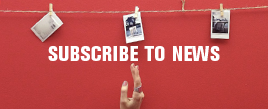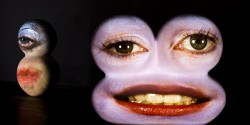The PinchukArtCentre (Kyiv, Ukraine) presents the first major solo exhibition by Tony Oursler in Eastern Europe entitled “agentic iced etcetera”. The exhibition combines specially produced new works, including a Ukrainian speaking installation, with some of the most iconic pieces of the artist. Themes within the exhibition include chance in everyday life, endorphin fuelled relationships, and the tendency for magical thinking to name a few. The human face and the way it simultaneously communicates and masks emotions is also a key theme in Oursler’s work.
Eckhard Schneider, General Director of the PinchukArtCentre: “Tony Oursler (born 1957) is one of the pioneers of the genre. For Oursler video is a medium comparable to water in its extreme fluidity, one that had remained imprisoned within television for fifty years. He has not only succeeded in liberating video from the screen, but also in developing it into video sculpture. His works are introspections on the human psyche under the influence of mass media. The majority of the work that will be on show has been created especially for the PinchukArtCentre – a dramatic labyrinth of sensations.”
From his earliest videos and installations, the mutability of human nature has been the central theme of Tony Oursler’s work, fuelled by his fascination with the inner workings of the psyche and belief systems . The resulting sculptures, videos and installations challenge the viewer’s preconceptions of rationality, schizophrenia and culturally constructed notions of good and evil.
Formally, Oursler has developed a wide-ranging use of materials such as resin, glass, fabric, steel and various found objects, which are kaleidoscopically overlaid with projection, light and sound, forming a unique embodiment of his themes. Oursler’s work invites viewers to question their relationship with mass (multi-) media and reaches from an examination of television (and its surrounding structures) to a questioning of the psychological effects of digital communication tools like mobile phones and the Internet.
Projecting moving images onto objects, Oursler moves beyond traditional uses of media such as cinema, television and the computer and creates something akin to “living” sculptures. The scenarios he devises are often full of poetic and humorous performances, incorporating all manner of physical and auditory representations of the human form. The works incorporate a spectrum of voices reflecting numerous performative and literary approaches – florid poetics, interior monologues, tortured fragments or scientific jargon. Viewers are invited to complete the script as they move through the exhibition and confront open-ended, often existential constructs.
Oursler also explores the interaction between sculpture and spectator. He is aiming for a conversational structure in which the object not only speaks but also provokes the viewer’s imagination.
The human face reoccurs as subject in “Caricatures” (since 2002), works in which biomorphic sculptural objects become caricature-like forms literally brought to life by videos of eyes and mouths that take over the unnatural proportions of the sculptural object. These works explore the viewer’s empathic relationship and echo the history of caricature, ranging from early sculptural forms such as the Venus of Willendorf to the ubiquitous smiley face.
The artist’s so-called “micro works” are almost like living embodiments of thought structures. Oursler’s interest in memory, construction and new scientific discoveries and ontological systems form the basis of these wildly imaginative microcosms. Landscape, architecture, found objects and amorphic materials are overlaid with tiny projections which complete the surreal, microscopic world. Elaborately edited looping structures cover these small forms and upturn the relationship with the spectator. Each micro-world is displayed at eye level and mirrors the scale of the human cranium.
On the other hand, the overwhelming scale of “Lock” (2011) semi-forces the viewer into a total, physical experience of image and sound. Viewers are dwarfed by the three enormous characters who make up the work and as they pass through the maze of this projected world, they experience three layers of interlocking characters: the first representing free will and agency; the second representing the status quo and human error; the third representing mathematical symmetry and death. This monumental installation involves key performances by artist/filmmaker Tony Conrad, vocalizations by singer/performer Chanique Rogers, a sound collaboration with Dan Lloyd (Brownell Professor of Philosophy at Trinity College, Hartford) and musical compositions generated from functional MRI (Magnetic Resonating Image) readouts of psychological test subjects. The installation has the appearance of a secretive yet familiar system, loosely divided between the mind, body and environment, in which synchronized images shift to form a colourful game.
Finally, the exhibition features a screening room of music-themed video. The screening includes numerous collaborations, including those with Sonic Youth, Beck, Kim Gordon, Stephen Vitiello and Glenn Branca as well as featuring Oursler’s recently released music/video collaboration with David Bowie.
The exhibition will be open from February 16 till April 21, 2013 in the PinchukArtCentre. Admission is Free.
Tony Oursler graduated from the California Institute of the Arts in 1979 and is currently based in New York. Oursler’s works have been widely exhibited internationally, including solo shows at the ARoS Aarhus Kunstmuseum (2012); Padiglione d’Arte Contemporanea, Milan (2011); Whitney Museum of American Art, New York (2010); Kunsthaus Bregenz (2009); Kunstforeningen GL Strand, Copenhagen (2006); Musee d’Orsay, Paris (2004) and many more. Group exhibitions include the Museum of Art and Design, New York (2012); Cincinnati Art Museum (2011); Carnegie Museum of Art, Pittsburgh (2010); Whitney Museum of American Art, New York (2010) and the Museum of Modern Art, New York (2008). 1 Elizabeth Janus, “Talking Back – A Conversation with Tony Oursler”, in Tony Oursler: Introjection (Williamstown: Williams College Museum of Art, 2010). Unpaginated pdf on the artist’s website, www.tonyoursler.com.



